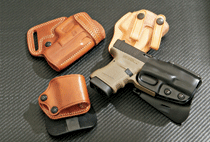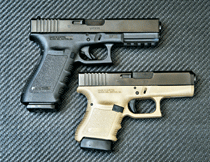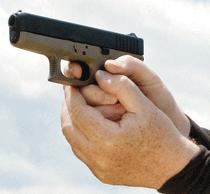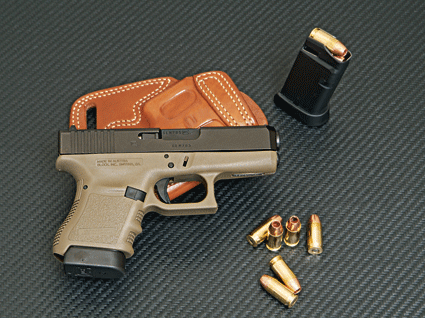Who says a backup gun has to be a .380 or .25ACP semi-auto or a snub nose .38 Special revolver? It would be far more advantageous if your backup were the same caliber as your primary sidearm and better still if it were of the same design, just smaller. This is what the Glock 36 brings to the table, a compact .45ACP that perfectly complements the Glock 21 or 21SF. My G21SF has given me a rather unique perspective on the G36, which is a much smaller gun, yet packing 6 + 1 rounds of .45ACP. I have also carried a Smith & Wesson Model 25-2 and a Model 325PD .45ACP revolver. While my general preference for a carry gun is a revolver, my overriding inclination is for the stopping power of a CorBon JHP .45ACP or similar cartridge. The Glock 21SF was the first .45ACP to make me a convert. It is, however, a hefty piece to carry, even in the abridged “short frame” version.
Most people licensed to carry concealed lean toward smaller, more easily handled semi-autos and revolvers such as the ever popular Walther PPK/S .380ACP, the new Ruger LCP .380ACP, and the old standard .38 Special S&W M36, or my personal favorite, the M640 “Carry Comp” that was built by the S&W Custom Shop in 1993. Still, the advantages of both greater capacity and a more powerful cartridge have an irresistible allure and the G36 handily fills this niche.
Gun Details
Advertisement — Continue Reading Below
The G36 is in a unique Glock category, the only model listed under “Sub-compact Slimline.” The Glock Slimline semi-autos cover the entire range of calibers from 9mm to .357 SIG. However, the G36 is noticeably different from the sub-compact G30 chambered in .45ACP. The G30 has a standard 10 + 1 capacity and measures 4.76 inches in height, 6.77 inches in length, 1.27 inches in width and weighs 23.99 ounces empty, with a 3.78-inch barrel length, and a sight radius of 5.95 inches. In comparison, the G36 “Slimline” uses a single stack magazine limited to 6 rounds, and employs Glock’s narrower secure-grip design reducing width to only 1.13 inches. The G36 tips the scale at just 20.11 ounces empty making it not only a narrower but lighter gun to carry. And let’s face it, lighter is better. Interestingly, the line of sight on the G36 is nearly 0.25 of an inch longer, yet height and length are identical to the G30. The difference in width is taken up by the G30’s staggered stack magazine. Thus, to get the smaller grip size and more easily concealed profile you sacrifice 4 rounds. That’s why you always carry a second magazine, which Glock supplies with the G36.
Like all Glocks, the G36 is a striker-fired DAO utilizing the Glock “Safe Action” design. When the slide is cycled, the firing pin is set in a half-cocked “safe” position, and is activated only by the trigger safety release toggle, which disengages the firing pin safety allowing the gun to fire. The safety being built integral with the trigger is especially good if you are in a situation where you are on the move or engaging multiple targets. As soon as your finger is off the trigger the gun is in a safe condition and a third safety interlock prevents the gun from discharging if it is dropped. While some have criticized the Glock’s trigger safety, as opposed to a manually set safety, it is a very deliberate design. The gun only fires if you pull the trigger. No other operation is required to take it from a safe to fire mode. It is also immediately obvious if the gun is cocked. The trigger remains in the rearmost position when not cocked and moves forward when the slide is cycled. It is also easy to see and feel if a round is chambered because the extractor projects out slightly from the slide when a cartridge is loaded. This is an important visual check, as the gun could be cocked and a round not chambered.
activated only by the trigger safety release toggle, which disengages the firing pin safety allowing the gun to fire. The safety being built integral with the trigger is especially good if you are in a situation where you are on the move or engaging multiple targets. As soon as your finger is off the trigger the gun is in a safe condition and a third safety interlock prevents the gun from discharging if it is dropped. While some have criticized the Glock’s trigger safety, as opposed to a manually set safety, it is a very deliberate design. The gun only fires if you pull the trigger. No other operation is required to take it from a safe to fire mode. It is also immediately obvious if the gun is cocked. The trigger remains in the rearmost position when not cocked and moves forward when the slide is cycled. It is also easy to see and feel if a round is chambered because the extractor projects out slightly from the slide when a cartridge is loaded. This is an important visual check, as the gun could be cocked and a round not chambered.
The Glock uses a composite frame combined with a metal slide and barrel, both with a durable Tenifer finish. The composite frame on our test model is the OD green version sold only in the US market. This was a standard equipped gun with polymer front and rear sights, the front with a wide post and dot-shaped white contrast insert, the rear with a fixed dovetail sight and clear contrast white inserts. This proved to be a superb combination under all but the lowest lighting conditions. Glock also offers optional steel sights, adjustable rear sights, and luminous night sights.
Advertisement — Continue Reading Below
The optional OD green frame adds a military look to the G36 and a sharp contrast to the durable black Tenifer finished slide. Overall, for a very utilitarian sidearm, it’s a pretty sharp-looking gun.
Leather Options
There are a number of fine holsters available for the G36 and we chose four from Galco  including the SOB (small of back) holster. We also tried the Summer Comfort inside the waistband (IWB) holster; the Yaqui Paddle holster (a personal favorite) and the new Matrix M5X thermoplastic paddle holster. Part of the “Matrix Series,” the Matrix M5X is by far the most secure for the G36, with the gun locking into the molded body of the holster. The Yaqui Paddle is another great design that keeps the G36 tightly retained with a minimum of leather and a secure thermoplastic paddle that fits comfortably against the body. Because the Yaqui Paddle slides so easily around a belted pair of trousers it is the easiest to move, depending upon conditions, from a strong-side draw to crossdraw to an over the hip position for better concealment. The G36 also clears leather much faster in the low-cut Yaqui Paddle.
including the SOB (small of back) holster. We also tried the Summer Comfort inside the waistband (IWB) holster; the Yaqui Paddle holster (a personal favorite) and the new Matrix M5X thermoplastic paddle holster. Part of the “Matrix Series,” the Matrix M5X is by far the most secure for the G36, with the gun locking into the molded body of the holster. The Yaqui Paddle is another great design that keeps the G36 tightly retained with a minimum of leather and a secure thermoplastic paddle that fits comfortably against the body. Because the Yaqui Paddle slides so easily around a belted pair of trousers it is the easiest to move, depending upon conditions, from a strong-side draw to crossdraw to an over the hip position for better concealment. The G36 also clears leather much faster in the low-cut Yaqui Paddle.
Advertisement — Continue Reading Below
The Galco SOB places the gun at a cant with grips up. Not only does this offer excellent concealment with the tensioning screw firmly holding the gun in place, but it still is very easy to draw and re-holster. This is a very durable rig with hand molding, stitched leather sight rails and a double thick stitched throat. It is definitely one of the finest holsters we have tested and surprisingly comfortable when sitting or driving, although I wouldn’t recommend extended respites on a park bench.
Check out our Comprehensive Guide to Buying the Right Concealment Holster.
Range Time
Advertisement — Continue Reading Below
The compact G36 managed felt recoil extremely well, even with the hot CorBon loads. The grip design helps to absorb recoil and the balance of the gun, which is excellent, helps you quickly get back on target. Even after more than 100 rounds, wear and tear on the shooting hand was minor.
The G36 seems to feed on anything you put in the magazine and we ran the gambit from less expensive Blazer Brass 230-grain FMJ to the costly but very accurate and manageable CorBon 160gr DPX rated at 1050 feet per second (fps). Recoil is snappy with the CorBon, but the end result is a clean hit with a round that offers superior stopping ability due to the expansion and deeper penetration of its solid copper bullet.
Our test range distances were 10 meters, 25 feet (with the LaserMax under low light conditions), and 50 feet. Yes, these are all close ranges but in the world where a gun like the G36 might come into play, these are the most likely distances from which a target may be engaged. Firing two 5-round strings in 10-second intervals at 10 meters the UMC placed 9 rounds in the 9 ring of a B-27 silhouette and 1 in the 10. The 200-grain CorBon delivered 7 in the 9 and 3 in the 10 closely grouped. Using the 160-grain CorBon, the results were nearly identical with 7 in the 9, 2 in the 10 and one slight flyer cutting the 8. Stepping out to 50 feet the UMC recorded 5×9, 3×8, and 2×7. CorBon averaged 3×10, 4×9 and 4×8. All well within the body mass.
Advertisement — Continue Reading Below
The LaserMax guide rod-mounted laser proved extremely helpful under low light conditions (dusk and indoors for sighting tests). On the test range just before sundown we delivered 5 rounds slow fire from 25 feet with the first group measuring 1.75 inches splitting the 9 and 10 rings and a second volley fired as quickly as possible landing all five within the 10 and X bull. Needless to say the LaserMax works well, while green laser sights are modestly effective in bright light conditions, the Red LaserMax is designed for low light use, which is when you would need it the most. The LaserMax features a pulsating beam for fast acquisition in dim or dusky light. It is easily activated by either the trigger finger or off-hand thumb by sliding the Glock’s takedown lever full left or full right. The LaserMax switch replaces the standard takedown lever and serves the dual purposes. As for compactness and ease of installation and operation the LaserMax is faultless.
we delivered 5 rounds slow fire from 25 feet with the first group measuring 1.75 inches splitting the 9 and 10 rings and a second volley fired as quickly as possible landing all five within the 10 and X bull. Needless to say the LaserMax works well, while green laser sights are modestly effective in bright light conditions, the Red LaserMax is designed for low light use, which is when you would need it the most. The LaserMax features a pulsating beam for fast acquisition in dim or dusky light. It is easily activated by either the trigger finger or off-hand thumb by sliding the Glock’s takedown lever full left or full right. The LaserMax switch replaces the standard takedown lever and serves the dual purposes. As for compactness and ease of installation and operation the LaserMax is faultless.
Final Notes
The Glock 36 proved to be an ideal defensive handgun with rugged construction, light weight and exceptional balance. The gun comes in a hard case with an extra magazine, speed loader and a cleaning brush. For a price around $600 the G36 is a lot of gun for the money. It is a proven design with field-tested technology that has been embraced by law enforcement organizations the world over. It is an almost indestructible handgun. If the power of a .45ACP is what you want in a compact personal carry gun, than take a look at the Glock 36.
Advertisement — Continue Reading Below
























